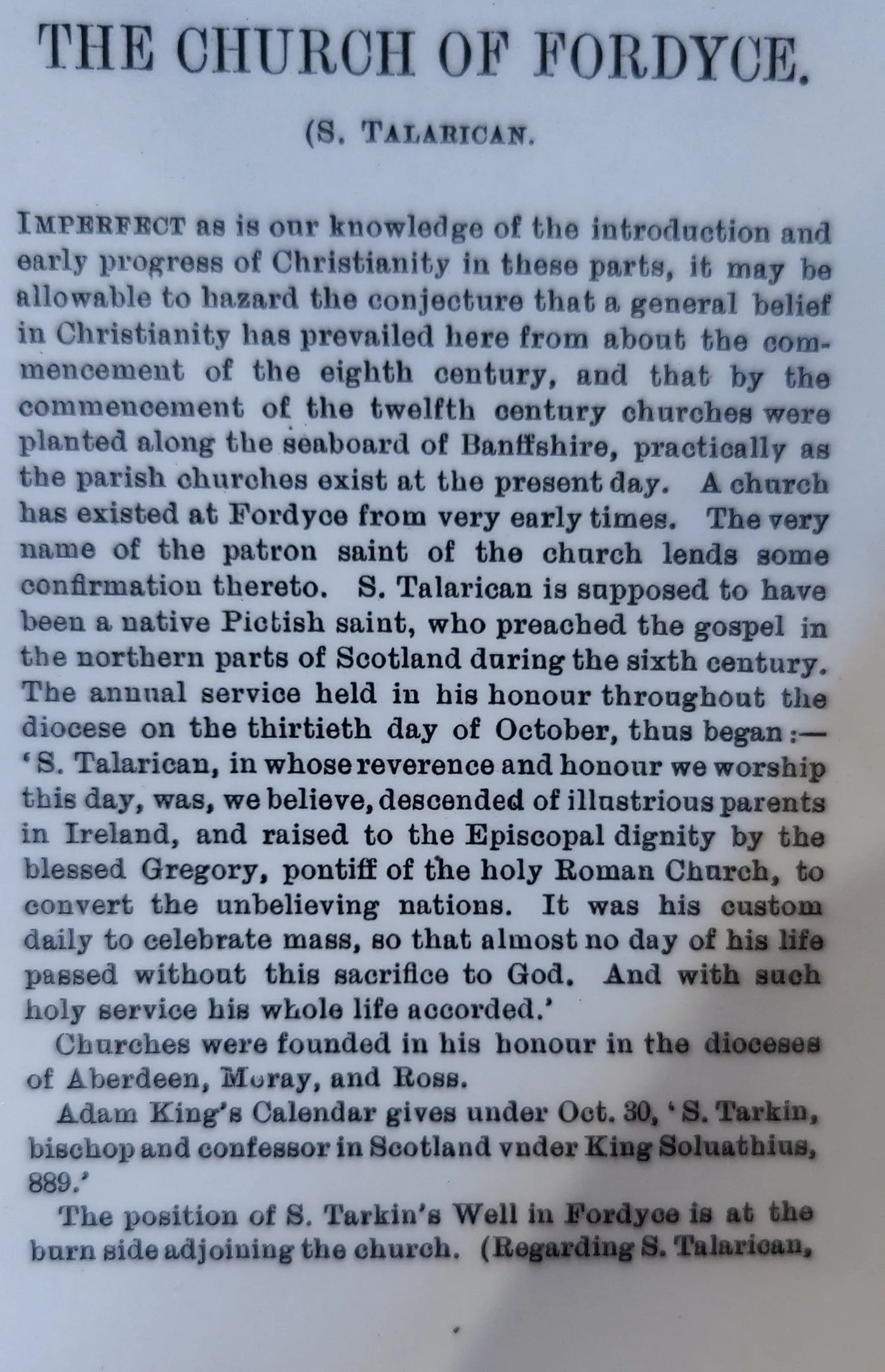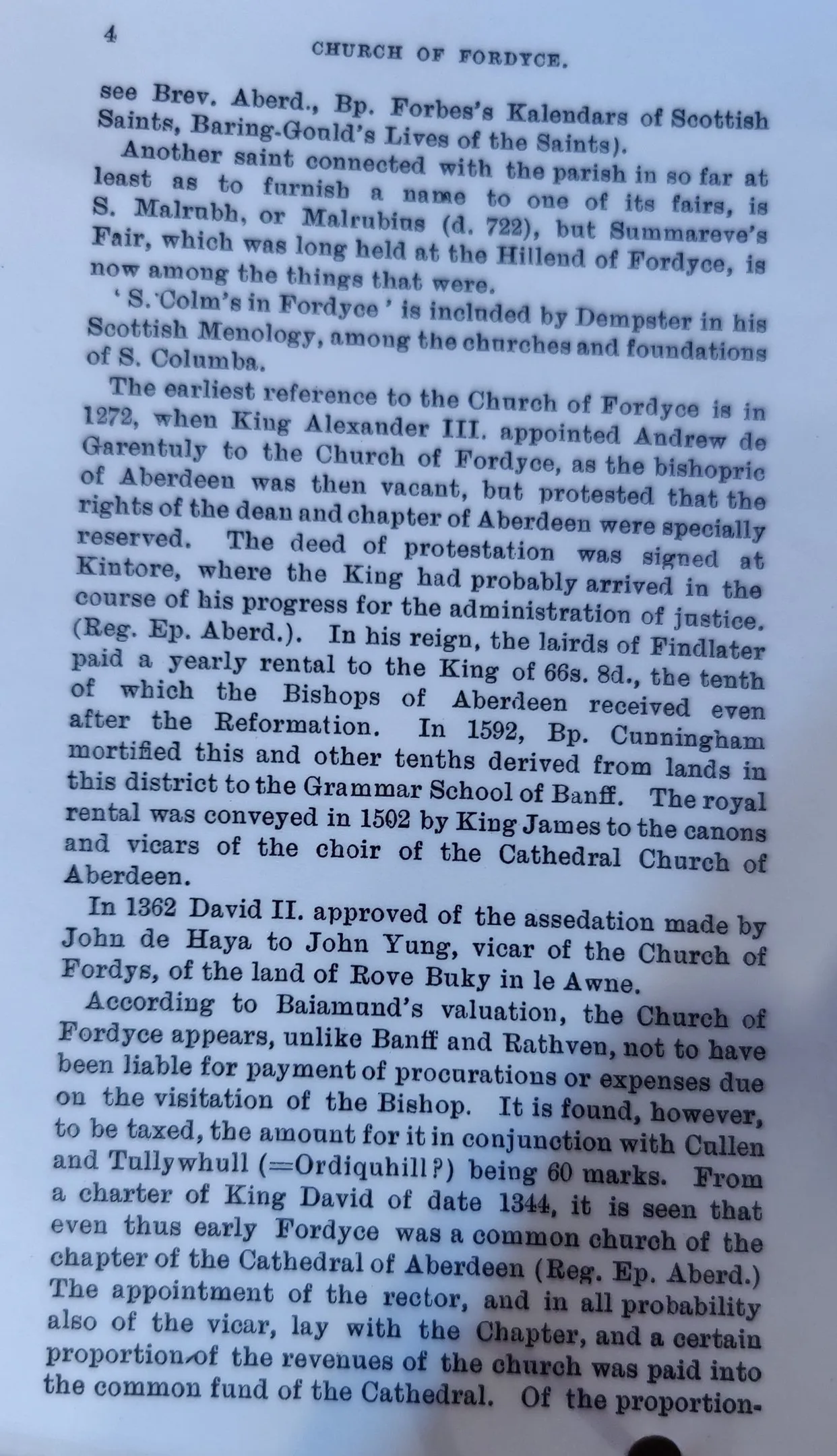The Kirk
A church has stood on this site since the 6th century. It was originally associated with St Talorcian (or Tarquin), a native Pictish Saint who was made the first bishop. St Tarquin’s Well, a healing well associated with the Saint, can still just be made out on the west side of the Glassaugh Burn, by Haughton Cottage on the right-of-way.
The ancient kirk was confirmed as a common church of the Cathedral of Aberdeen by Bishop John as early as 1351. An even earlier reference (1272) records the confirmation of Andrew de Garcethy as minister by King Alexander III. The church was rebuilt many times, and only a fragment of the main structure survives. It originally consisted of a nave with aisles to the west and south. The picturesque belfry dates from 1661 and tops the ancient porch and session-house.
The west aisle belonged to the Ogilvies of Dum. The Dum Aisle was founded in 1516, originally as St Mary’s Chapel, by Sir William Ogilvie of Strathelen. His granddaughter, Margaret, married Thomas Menzies of Kirthill. Their son Thomas, Laird of Dum, built Fordyce Castle and endowed the original school. Menzies, the castle’s founder, lies in the Dum Aisle.
The south side, now divided, belonged to the Abercrombies of Birkenbog (later Glassaugh) and the Ogilvies of Findlater. The name Abercromby of Glassaugh can be seen on the north wall of the Glassaugh Aisle, and there is a marble monument to James Abercromby of Glassaugh (d. 1781), the army general associated with Ticonderoga.
Another effect of the Reformation was the policy of the Bishops of Aberdeen to feu out the church lands to the local Ogilvies of Boyne. Today, these lands form part of Seafield Estates.
In the troubled times of the Reformation, according to an early Parish Register (around 1574), the minister Gilbert Gardin (Gardyne) “seldom went to the pulpit without his sword, for fear of the Papists.” In 1571, he was Moderator of the General Assembly. His first wife’s gravestone in the kirkyard was recorded as still readable in 1925.
Produced by the Forward Planning Projects Section of Aberdeenshire Council, in association with Gilbert Summers, writer.

The Church of Fordyce (St Talarican)
IMPERFECT as is our knowledge of the introduction and early progress of Christianity in these parts, it may be allowable to hazard the conjecture that a general belief in Christianity has prevailed here from about the commencement of the eighth century, and that by the commencement of the twelfth century churches were planted along the seaboard of Banffshire, practically as the parish churches exist at the present day. A church has existed at Fordyce from very early times. The very name of the patron saint of the church lends some confirmation thereto. S. Talarican is supposed to have been a native Pictish saint, who preached the gospel in the northern parts of Scotland during the sixth century. The annual service held in his honour throughout the diocese on the thirtieth day of October, thus began:—
“S. Talarican, in whose reverence and honour we worship this day, was, we believe, descended of illustrious parents in Ireland, and raised to the Episcopal dignity by the blessed Gregory, pontiff of the holy Roman Church, to convert the unbelieving nations. It was his custom daily to celebrate mass, so that almost no day of his life passed without this sacrifice to God. And with such holy service his whole life accorded.”
Churches were founded in his honour in the dioceses of Aberdeen, Moray, and Ross. Adam King’s Calendar gives under Oct. 30, “S. Tarkin, bishop and confessor in Scotland under King Soluathius, 889.” The position of S. Tarkin’s Well in Fordyce is at the burn side adjoining the church. (Regarding S. Talarican,

see Brev. Aberd., Bp. Forbes’s Kalendars of Scottish Saints, Baring-Gould’s Lives of the Saints)
Another saint connected with the parish in so far at least as to furnish a name to one of its fairs, is S. Malrubh, or Malrubius (d. 722), but Summareve’s Fair, which was long held at the Hillend of Fordyce, is now among the things that were.
“S. Colm’s in Fordyce” is included by Dempster in his Scottish Menology, among the churches and foundations of S. Columba.
The earliest reference to the Church of Fordyce is in 1272, when King Alexander III. appointed Andrew de Garentuly to the Church of Fordyce, as the bishopric of Aberdeen was then vacant, but protested that the rights of the dean and chapter of Aberdeen were specially reserved. The deed of protestation was signed at Kintore, where the King had probably arrived in the course of his progress for the administration of justice (Reg. Ep. Aberd.). In his reign, the lairds of Findlater paid a yearly rental to the King of 66s. 8d., the tenth of which the Bishops of Aberdeen received even after the Reformation. In 1592, Bp. Cunningham mortified this and other tenths derived from lands in this district to the Grammar School of Banff. The royal rental was conveyed in 1502 by King James to the canons and vicars of the choir of the Cathedral Church of Aberdeen.
In 1362, David II. approved of the assedation made by John de Haya to John Yung, vicar of the Church of Fordys, of the land of Rove Buky in le Awne.
According to Baiamund’s valuation, the Church of Fordyce appears, unlike Banff and Rathven, not to have been liable for payment of procurations or expenses due on the visitation of the Bishop. It is found, however, to be taxed, the amount for it in conjunction with Cullen and Tullywhull (=Ordiquhill?) being 60 marks. From a charter of King David of date 1344, it is seen that even thus early Fordyce was a common church of the chapter of the Cathedral of Aberdeen (Reg. Ep. Aberd.). The appointment of the rector, and in all probability also of the vicar, lay with the Chapter, and a certain proportion of the revenues of the church was paid into the common fund of the Cathedral.
Of the proportion-

ate allowances made to a particular church, the rector and vicar usually received two-thirds and one-third respectively. A charter of Bp. John Rait, of date 1351, confirms the church as belonging to the Dean and Chapter of the Cathedral Church of Aberdeen. This charter is again referred to as existing in 1436. In 1520, the chapter set the churches of Fordyce, Cullen, and Ordiquhill for £206 6s. 6d., and the vicarage of Fordyce for £80.
As the Reformation approached, leases of church property became more frequent. The following is one example:—
Assedatioun made be the bischop with consent of his cheptour to Maister Alexander Ogiluy, in Glassauch, of the landis of Glassauch, with the Cragmyln of the samyn lyand within the lordschipe of Fordice and sherefdom of Banff, togidder with the sukyn and multuris of the said lordschipe of Fordice for the terme of nineteene zeiris, payand thairfoir zeirlie the sowme of nyne pundis, togidder with ane chalder of quheit to be deliverit with the mesour of the common firlot of Aberdeen, and ane nychtis lugeing with supper and dyner to the bischop quhen it sall happin him to cum in the cuntre. At Edinbrugh, xxiij July A.D. M.D.XXXV.
This lease was confirmed by the chapter to Alexander Ogilvy and Jonete Bard, his spouse, in the following month.
In 1362, the dean and canons of the chapter of the Cathedral of Aberdeen founded a chaplainry, in the Cathedral Church, to pray for the souls of King David and others. The chaplain was appointed to receive 100s. of the fruits of the church of Logy in Buchan, and, in case the fruits of that church were insufficient, they appointed the fruits of their common church of Fordyce for payment of the aforesaid sum.
Besides the second tithes already referred to, the bishops of Aberdeen were deriving, in 1511, considerable revenue from the lordship of Fordyce:— ‘Lordship of Fordyce—Glassauch with the mill, 3 ploughs, is set for nine pounds and twelve bolls of corn to Mr Alexander Ogilvy. The Kirktown and Petchadle, 3 ploughs, is set for two chalders of corn to Sir William Ogilvy of Stratherne. The burgage of the Kirktown of Fordis. This town of Fordis was erected a free burgh of barony.”
